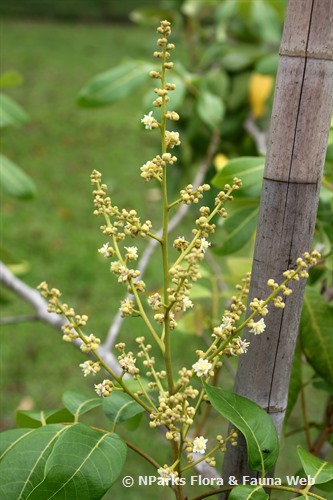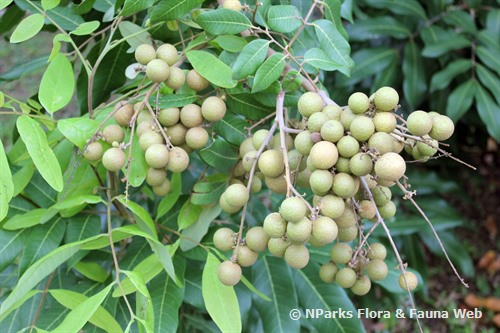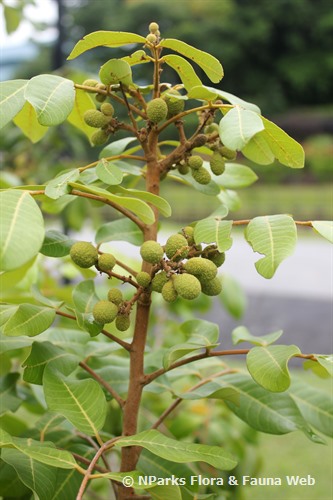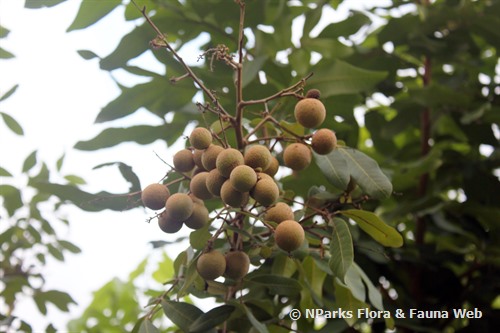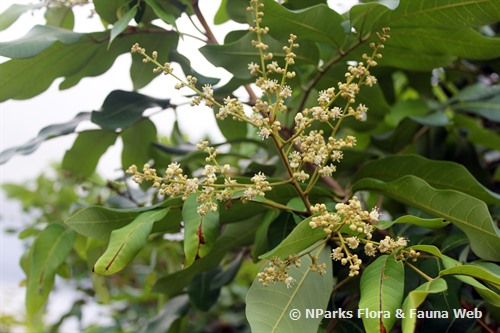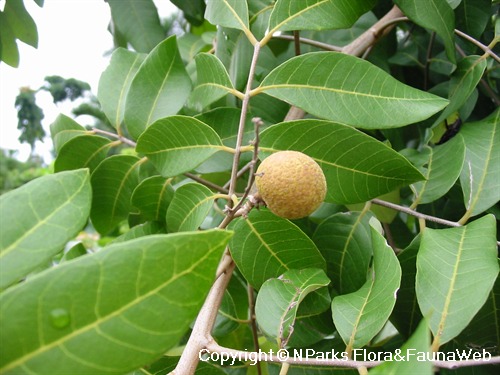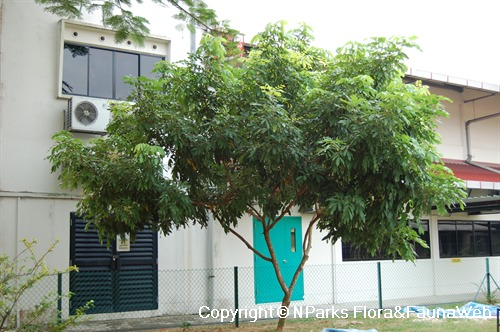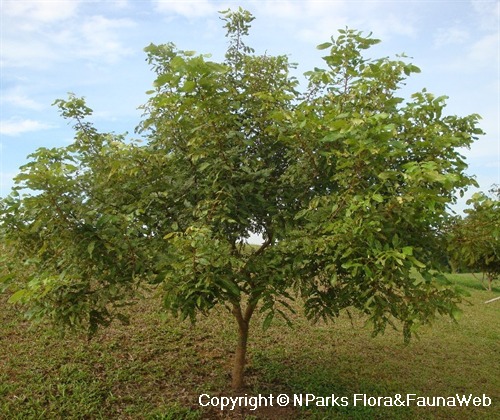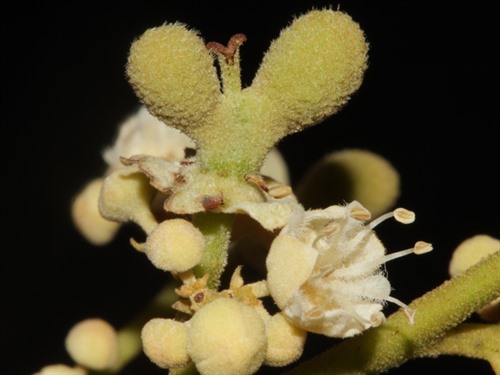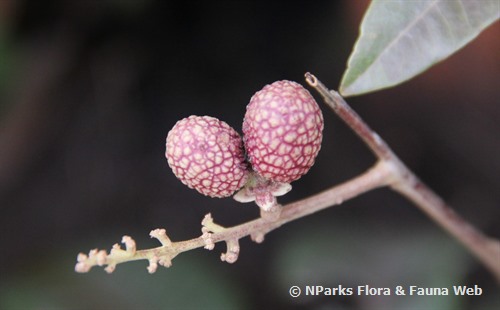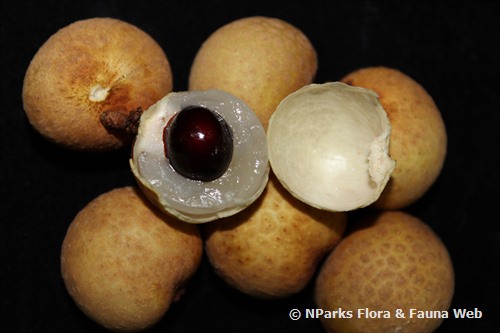
Back
Dimocarpus longan Lour.
| Family Name: | Sapindaceae |
| Common Name: | Longan, Mata Kuching, Lungen, Dragon's Eye, 龙眼 |
Dimocarpus longan, commonly known as Longan, is a tree which can reach up to 40 m in the wild. It is prized for its round, smooth fruit which ripens to yellow-brown. The seed is surrounded with a juicy sweet-tasting pulp.
Name
Classifications and Characteristics
| Plant Division | Angiosperms (Flowering Seed Plants) (Dicotyledon) |
|---|---|
| Plant Growth Form | Tree |
| Lifespan (in Singapore) | Perennial |
| Mode of Nutrition | Autotrophic |
| Plant Shape | Rounded |
| Maximum Height | 40 m |
| Tree or Palm – Trunk Diameter | 1 m |
Biogeography
| Native Distribution | From Sri Lanka, India, Southern China to Malesia (excluding Singapore). |
|---|---|
| Native Habitat | Terrestrial (Monsoon Forest) |
| Preferred Climate Zone | Sub-Tropical / Monsoonal |
| Local Conservation Status | Non-native |
Description and Ethnobotany
| Growth Form | A large tree that grows up to 40 m tall with a round-topped crown of dense leaves. |
|---|---|
| Foliage | Leaves compound, with elliptical leaflets that have soft hairs above at the basal part of the mid-rib and tufts of soft hairs beneath mainly on the midrib and nerves. |
| Stems | Trunk reaching 1 m in diameter, sometimes buttressed. Branches terete (= slender like a tapering cylinder and more or less circular in cross-section) with five faint grooves, sometimes with warty pores, known as lenticels, and densely covered with rusty-brown soft hairs. |
| Flowers | Inflorescence terminal, 8-40 cm long, densely covered with soft hairs, bearing flowers that are pale yellow to yellow-brown and fragrant. Petals are densely woolly to glabrous (= without hairs). |
| Fruit | Fruit a yellow-brown drupe (= a fleshy fruit containing one or more seeds, each enclosed within a stony layer), 1-3 cm in diameter, surface smooth to warty and granular to touch. Each fruit contains a single shinny blackish-brown seed that is covered by a thin translucent white fleshy layer. |
| Habitat | D. longan is a subtropical species that also grows well in the tropics. A distinct change of seasons is needed for satisfactory flowering to occur, with prolific blooming occurring with a short cool winter season. |
| Cultivation | D. longan thrives on rich sandy loams, while moderately acidic sandy soils are less preferred and organic humus-rich soils reduces flowering in plants probably because shoot growth is encouraged instead. The tree requires moderate to lots of water, but should not be over-watered. D. longan is suitable for growing indoors and in pots. Propagation methods include air layering, grafting and seed. |
| Etymology | Dimocarpus the genus name is from the Greek “dis”, meaning twice, and “karpos” meaning fruit, likely referring to the two-lobed pistil. The specific epithet, longan, is derived from the Mandarin “long yan” (龙眼), literally meaning “dragon’s eye”, in reference to the resemblance of fruits of D. longan to dragon eyes. |
| Ethnobotanical Uses | Edible Plant Parts : Edible Fruits, Edible Leaves, Edible Flowers, Edible Seeds Food (Fruit or Vegetable): Fruits of D. longan, otherwise commonly called longans, are mainly eaten fresh. Longans may also be canned in its own juice with little or no sugar to prolong the lifespan of the fruits. Canned longans are thought to retain their flavour better than canned lychees (Litchi chinensis) and rambutans (Nephelium lappaceum). In addition, longans can be preserved by drying, either with the fruit covering intact or removed, with the result being a sweet leathery black flesh that is used in flavouring and to make beverages, including liquor. Medicinal: The fruit flesh and seeds of D. longan have medicinal uses, while leaves and flowers are used by the Chinese as herbs. Timber & Products: Timber from D. longan is red and hard, but rarely available although useful. Cultural / Religious: Heritage Tree: There is currently 1 individual of Dimocarpus longan listed as Heritage Trees in Singapore. It can be found in Sembawang Park. To find out more about this tree, please visit the Heritage Tree Register. Others: Seeds are used as a shampoo. |
Landscaping Features
| Desirable Plant Features | Ornamental Foliage, Fragrant (Flowers) (Day) |
|---|---|
| Landscape Uses | Shade Providing Tree / Palm, Focal Plant, Container Planting |
Fauna, Pollination and Dispersal
| Pollination Method(s) | Biotic (Fauna) |
|---|
Plant Care and Propagation
| Light Preference | Semi-Shade, Full Sun |
|---|---|
| Water Preference | Moderate Water, Lots of Water |
| Plant Growth Rate | Moderate |
| Rootzone Tolerance | Fertile Loamy Soils, Well-Drained Soils, Acidic (low pH) Soils |
| Propagation Method | Seed, Grafting, Air-Layering |
Foliar
| Mature Foliage Colour(s) | Green |
|---|---|
| Mature Foliage Texture(s) | Hairy / Hirsute |
| Foliar Shape(s) | Non-Palm Foliage (Elliptical) |
| Leaf Area Index (LAI) for Green Plot Ratio | 3.0 (Tree - Intermediate Canopy) |
Non - Foliar and Storage
| Trunk Type (Non Palm) | Woody |
|---|
Floral (Angiosperm)
| Flower Colour(s) | Brown, Yellow / Golden |
|---|
Fruit, Seed and Spore
| Mature Fruit Colour(s) | Brown, Yellow / Golden |
|---|---|
| Fruit Type | Fleshy Fruit , Drupe |
Image Repository
Others
| Master ID | 1555 |
|---|---|
| Species ID | 2848 |
| Flora Disclaimer | The information in this website has been compiled from reliable sources, such as reference works on medicinal plants. It is not a substitute for medical advice or treatment and NParks does not purport to provide any medical advice. Readers should always consult his/her physician before using or consuming a plant for medicinal purposes. |

